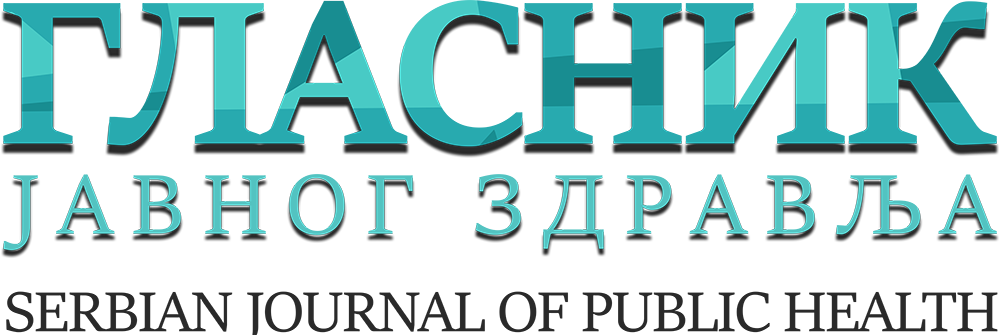

Архива






GENERAL INFORMATION
Serbian Journal of Public Health (SerbJPH) is a multidisciplinary journal publishing articles from all fields related to public health, in Serbian and in English.
The Journal publishes the following types of articles: original scientific papers, reviews, preliminary and brief statements, case studies, editorials, letters to the editor, reports from scientific meetings and congresses, and other articles.
The Journal is published quarterly, both in print and in digital format. The opinions expressed in the published articles represent the opinions of authors and do not necessarily reflect the views of the institution – publisher.
ARTICLE SUBMISSION
An article that is thematically relevant to the Serbian Journal of Public Health shall be submitted in digital format. Authors shall submit statements attesting that the results had not been published before, i.e., the articles shall not simultaneously be sent to another journal for publishing. If the paper is a part of a doctoral thesis or a research project, it shall be duly noted at the end of the text. In addition, articles sent for publishing may be pre-printed in proceedings, as abstracts, and when this is the case, the title, time and place of the meeting where the paper was presented and its abstract printed shall be noted in the application.
To consider a manuscript for publication, the manuscript needs to adhere to the eligibility criteria of the Serbian Journal of Public Health. Otherwise, the editor may reject the article without further explanation. If the article is acceptable in content, and in formal terms, it shall be sent for anonymous review to two reviewers, experts in the appropriate public health field. Both the authors and the reviewers shall remain blinded to the identity of the other parties. Objections and suggestions from the reviewers shall be sent to the corresponding author, for final editing of the article. The article, which has been thus edited, shall be resubmitted to the Editing Board for publication approval. The final decision on publication shall be made with consent of the Journal Editor.
Serbian Journal of Public Health shall not charge, either authors or third parties, for the costs of publication. The article submission procedure, manuscript processing and publication shall be free of charge.
Manuscripts shall be submitted to the Editing Board by e-mail: glasnik@batut.org.rs or using the Journal’s online application form.
GENERAL INSTRUCTIONS
The article text shall be typed in the Office Word word processor, in Cyrillic, with 1.5 spacing, using the Times New Roman font, size 12. All margins shall be set to 15 mm, page size shall be set to A4, and the text shall be aligned to the left and each new paragraph indented by 10 mm; there shall be no hyphenation of words at the end of lines. Tabs and multiple spaces shall not be used for the purposes of text alignment; for this purpose, ruler alignment tools or the tools in the Toolbars menu shall be used. A single space shall be used after each punctuation mark. If the text requires the use of special symbols, the font Symbol shall be used for this purpose. If something is commonly emphasized by italic print, it shall be put in italic. All headings shall be written in bold, in capital letters.
The placement of figures, graphs and tables shall be noted in the text, but shall not be included in the manuscript. All graphic parts of the article shall be submitted in their original format, as appendices. For the elaboration of such graphic elements, standard Windows programs shall be used, preferably from the Microsoft Office package (Excel, Word, Graph). Enumerated tables and graphs (with legends), as well as images in graphic formats (.tif or .jpg) shall be attached in a size that is adequate for printing and at least 300 DPI in resolution.
MANUSCRIPT STRUCTURE
Cover letter shall include:
In addition, the cover letter shall confirm that all manuscript authors have participated in its writing and that they are familiar with and consent to the content of the submitted, final version. The letter shall explicitly emphasize that none of the article authors have any conflict of interest. If a conflict of interest is indisputably ascertained, the journal reserves the right to request and publish a suitable statement of the author regarding that fact, or to reject the manuscript.
Title page
The title page shall contain the title of the article (typed in capital letters, font 14, bold, in the centre of the page) and full names of all authors. Institutions to which the authors are affiliated shall be listed below their names. Institutions shall be enumerated, and appropriate numbers marked next to the authors’ names (in superscript). Full name, address, e-mail, phone and/or fax number shall be listed for the corresponding author. All further correspondence related to proofreading, corrections, modifications of the manuscript etc. shall be conducted with the corresponding author.
Abstract
The Abstract shall be a single paragraph, up to 350 words. Abstract shall not list any references. Abbreviations should be avoided, but if they must be used, they shall be defined the first time they appear. A list of keywords (up to five) shall follow, for indexing purposes. After the abstract in Serbian, there shall be an abstract in English (identical in structure to the abstract in Serbian), on the next page.
Keywords
List up to five keywords, or brief expressions, indicating the content of the manuscript/article.
ARTICLE STRUCTURE
Original scientific articles shall be organized in the following sections, with the headings: Introduction, Methods, Results, Discussion, Conclusion and References.
Case studies shall comprise: Introduction, Case presentation, Discussion, Conclusion and References.
Text structure of a review article shall comprise the following headings: Introduction, several other headings, Conclusion and References.
In other categories, the article may be structured at will.
Introduction
The Introduction shall point out the essence of the research subject and provide sufficient information to explain the issues that the article relates to. References that address the issues and themes of the article shall be listed. Objective of the article shall be stated in the last paragraph of the Introduction.
Methods
Generally known methods shall not be described in detail, rather, the reader shall be directed to referenced sources. If a new method or modification of an existing method are used, such a method shall be described in detail. Methods used in statistical analysis of data shall also be listed.
All articles, if applicable, should include an explicit statement on the ethical principles and statement on ethics committee approval.
Results
The section on results shall be presented in a logical order, reflecting the results of research/experiments. Results shall be presented clearly, and preferably statistically analysed.
Discussion
Results shall be discussed and compared to the findings of other, already published research in the relevant field.
Conclusion
The conclusion shall be clear and derived from the objectives and results of the research.
Acknowledgments
This is not mandatory, but if the research received financial or any other type of assistance from institutions or individuals, this is the section to list that.
Financing
All articles should have a funding acknowledgement statement for the research. Where no specific funding has been provided for the research, the authors should state that have not received financial support.
References
Literature used shall be listed in the text using Arab numerals in square brackets – for example: [1, 2], in the order in which they appear in the text. The number of references shall not exceed 30, except in case of a literature review that may list up to 50 references. When citing references, all authors shall be listed; however, if there are more than six authors, the first six shall be listed, followed by et al. References of articles accepted for publication, but not yet published, shall be labelled in press, with supporting evidence submitted to show that the article has been approved for publishing. Every reference shall include the DOI number of the article. Internet data shall be cited by including the date the data was accessed.
References are listed using Vancouver style (uniform requirements for manuscripts submitted to biomedical publications), as adopted by the International Committee of Medical Journal Editors (http://www.icmje.org); the same format is used by U. S. National Library of Medicine and scientific publications database. Examples of references (articles, books and other publications, digital, unpublished and other published material) can be found at here .
Annexes (Tables, Figures, Schemes and Drawings)
All annexes shall be appended at the end of the manuscript. All annexes shall be enumerated using Arab numerals, in the order they appear in the text. Any abbreviations used in titles, or any other part of the annexes, must be explained below the relevant annex.
Tables shall be labeled with Arab numerals in the order they are referenced in the text. Abbreviations used in the tables shall be defined in the legend below the table. Tables shall be created solely in MS Word, using the menu Table – Insert – Table, defining the desired number of columns and rows that will make up the table.
Figures shall be any form of graphics. Photographs, drawings, schematics and graphs may be published. Figures are labeled using Arab numerals in the order they are featured in the text. For the elaboration of such graphic elements, standard Windows programs shall be used, preferably from the Microsoft Office package (Excel, Word, Graph). All data in graphs shall be typed in Times New Roman font. Only digital photos shall be accepted (black and white or color), with a resolution of at least 300 DPI and in the .tiff or .jpg format. Legends in figures shall list the used magnification for microscope lenses (eyepiece and objective). Each photograph shall feature a visible scale. If the photograph has already been published, the source must be listed.
Schemes and drawings shall be submitted in .jpg or .tiff format. All data in schemes shall be typed in Times New Roman font, size 10 pt. Abbreviations used in the schemes shall be explained in a legend below the scheme.
ENVISAGED NUMBER OF PAGES FOR ARTICLES, INCLUDING ALL ANNEXES
Editorials – up to 5 pages: opinions or discussions regarding topics relevant for the publication, as well as on data published in this, or in other journals. These shall usually be written by a single author, by invitation.
Original articles – up to 12 pages. Presenting the results of research performed by their author, including their interpretation.
Review articles – up to 10 pages. Presenting a systemic, comprehensive and critical review of a problem based on analysed and discussed literature data, which reflects the current situation in a given field of research. Literature used in such an article must comprise at least three articles written by the review article authors, in the narrow field described in the article.
Preliminary or brief statements – up to 4 pages. Comprising exceptionally important scientific results that should be published as soon as possible. These shall not necessarily comprise a detailed description of the methods and results, but must include all headings contained in original articles, in a brief form.
Case studies – up to 6 pages.
Other articles (books and projects reviews, congress reports, articles in memoriam).